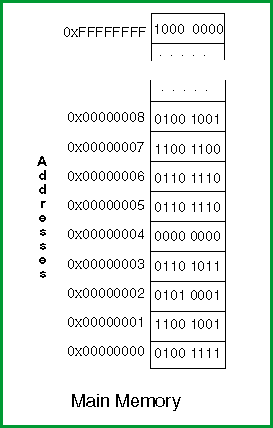A byte.

Each byte of main storage has an address. Many processors use 32-bit addresses, so there are 232 possible addresses. Think of main storage as if it were an array:
byte mainStorage[0x00000000 ... 0xFFFFFFFF];
A main storage address is an index into memory. A 32-bit address is the address of a single byte. Thirty-two wires of the bus contain an address (there are many more bus wires for timing and control).
Sometimes people talk about addresses like 0x2000, which looks like a pattern of just 16 bits. But this is just an abbreviation for the full 32-bit address. The actual address is 0x00002000.
The first MIPS processors (designed in 1985) used 32-bit addresses. From 1991 to present, top-end MIPS processors use 64-bit addresses.
The MIPS32 processor used in these notes is a modern chip designed for embedded applications. It uses 32-bit addresses, since embedded applications often don't need 64 bits. Recent processor chips from AMD and Intel have 64-bit addresses, although 32-bit versions are still available.
The assembly language of this course is for the MIPS32 chip, so we will use 32-bit addresses. The assembly language of the 64-bit MIPS chips is similar.
What is the hexadecimal name for the 32-bit pattern that consists of all 1 bits? (Hint: look at the picture.)